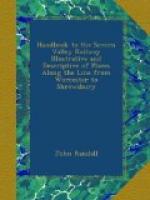The station, at the southern termination of the tunnel, is a chaste building of freestone, and forms an additional ornament to the town. It occupies a position from which its two divisions come pleasantly into view, the Low Town lying peacefully in the valley by the Severn, the High Town dotting the terraced sides, and crowning the bold impending rocks that give it, in the eyes of travellers, such an eastern aspect. Caverned in the hill, at many stages from its foot, and reached by winding walks, are picturesque holes and habitations—happily now no longer used, excepting in very few instances indeed—where the first settlers crowded when the ruthless Dane perched himself like a famished eagle on the rocks of Quatford down below. In the foreground are the time-worn relics of its two castles, to which the little colony was indebted for protection from fierce and threatening foes. The one opposite is Pampudding Hill, a smooth, grassy mound, on which the daughter of the great Alfred, Queen Ethelfleda, built a fortress. According to Florence of Worcester, what we now call Bridgnorth was then Brycge. In his time, as in that of Leland, who so well described its position, the Severn ran nearer to the frowning cliffs on which the town is built than at present.
The discriminating eye of the outlawed Belesme was not slow to perceive the advantages nature had given to the place, when he sought to raise a fortress that should shield him from the wrath of his royal master, and he removed the materials, it is said, of his house at Quatbrigia—a bridge having, it is supposed, succeeded the ford—to Brycge, afterwards Bridgnorth, or the bridge north of the one at Quatford. Florence of Worcester says: “Earl Robert carried on the works night and day, exciting Welshmen to the speedy performance of his wishes by awarding them horses, lands, asses, and all sorts of gifts.” With such aids, and advantages of site, the Norman earl erected a castle that held out three weeks against a large force marshalled by Henry, who, as an old Saxon chronicle states, came here “with all his army” to besiege it. It stood a second siege when Hugh de Mortimer espoused the cause of Stephen, and was attacked by Henry II., whose life was saved by the zeal of an attendant, who received a well-aimed arrow intended for the king. It was taken by the confederate barons, and retaken by Edward II., who afterwards marched to Shrewsbury, where the proud Mortimers humbled themselves and sued for mercy. It served not only as a garrison and a prison, but, from its position on the frontier of Wales, very often as a royal residence. King John came with a splendid retinue, of which the bishops of Lincoln and Hereford, the earls of Essex, Pembroke, Chester, Salisbury, Hereford, and Warwick formed part; upon which occasion the entertainment is said to have cost, for the three days it lasted, a sum equal to 2,000 pounds of modern currency. Prince Edward was a visitor after the battle of Evesham; and the second Edward too—the first time at the head of his army, the second, as a fugitive, crossing the Severn in a small boat at nightfall. Henry IV. was here:




